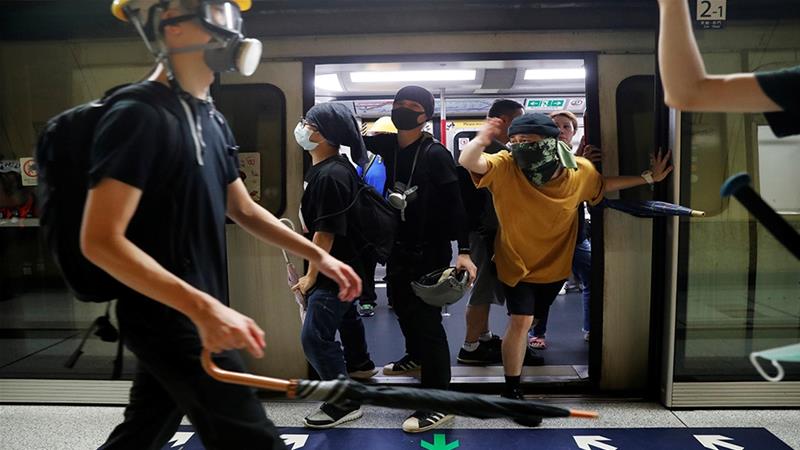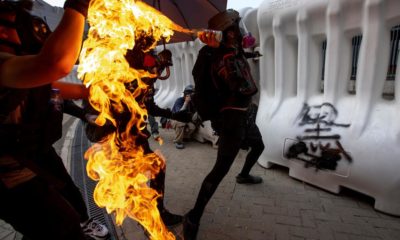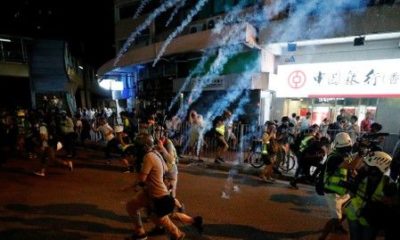Feature
Hong Kong protesters target trains, urge general strike

Hong Kong: Hong Kong pro-democracy protesters threw morning rush hour train travel into chaos on Monday, kicking off another day of potential turmoil after a weekend featuring some of the worst violence in three months of anti-government protests.
The global financial hub is in the midst of an unprecedented crisis as a largely leaderless movement has drawn millions on to the streets to protest against what they see as an erosion of freedoms and increasing interference in their affairs by Beijing.
In the latest action, protesters dressed in their signature black stood at doorways of trains, stopping them from closing, at a series of stations on the underground system on Monday morning, causing major delays on the network.
The protesters have also called for a general strike on Monday, while university students are due to rally in the afternoon. Hong Kong is a semi-autonomous southern Chinese city that operates under a “one country, two systems” framework, which gives citizens rights unseen on the mainland.
China committed to giving the people of Hong Kong those rights in an agreement that saw the city return from British colonial rule in 1997. China’s erosions of those rights has been one of the driving forces behind the protest movement.
The protests started in opposition to government plans to allow the extradition to the mainland of people wanted by Beijing, but have widened to include broader demands. These include demands for the extradition bill to be formally scrapped and for an independent inquiry into alleged police brutality during the protests.
On Sunday at least a dozen flights were cancelled after protesters blocked routes to the airport, although police fended off demonstrators’ efforts to converge on the terminal itself. On Saturday, hardcore protesters rampaged through the city centre, setting fires and throwing petrol bombs at riot police in defiance of a rally ban.
Police hit back with tear gas, baton charges and water cannon laced with chemical dye. Video footage captured by local media showed police charge and beat a crowd cowering inside a train carriage, with Amnesty International calling their actions “horrifying”. Universities were due to resume classes Monday after a summer break, but students who make up the backbone of the protest movement — are planning a two-week boycott. Protesters were also urging a general strike.
Entertainment
Meghalaya Reserves Legalized Gambling and Sports Betting for Tourists

The State Scores Extra High on Gaming-Friendly Industry Index
Meghalaya scored 92.85 out of 100 possible points in a Gaming Industry Index and proved to be India’s most gaming-friendly state following its recent profound legislation changes over the field allowing land-based and online gaming, including games of chance, under a licensing regime.
The index by the UK India Business Council (UKIBC) uses a scale of 0 to 100 to measure the level of legalisation on gambling and betting achieved by a state based on the scores over a set of seven different games – lottery, horse racing, betting on sports, poker, rummy, casino and fantasy sports
Starting from February last year, Meghalaya became the third state in India’s northeast to legalise gambling and betting after Sikkim and Nagaland. After consultations with the UKIBC, the state proceeded with the adoption of the Meghalaya Regulation of Gaming Act, 2021 and the nullification of the Meghalaya Prevention of Gambling Act, 1970. Subsequently in December, the Meghalaya Regulation of Gaming Rules, 2021 were notified and came into force.
All for the Tourists
The move to legalise and license various forms of offline and online betting and gambling in Meghalaya is aimed at boosting tourism and creating jobs, and altogether raising taxation revenues for the northeastern state. At the same time, the opportunities to bet and gamble legally will be reserved only for tourists and visitors.
“We came out with a Gaming Act and subsequently framed the Regulation of Gaming Rules, 2021. The government will accordingly issue licenses to operate games of skill and chance, both online and offline,” said James P. K. Sangma, Meghalaya State Law and Taxation Minister speaking in the capital city of Shillong. “But the legalized gambling and gaming will only be for tourists and not residents of Meghalaya,” he continued.
To be allowed to play, tourists and people visiting the state for work or business purposes will have to prove their non-resident status by presenting appropriate documents, in a process similar to a bank KYC (Know Your Customer) procedure.
Meghalaya Reaches Out to a Vast Market
With 140 millions of people in India estimated to bet regularly on sports, and a total of 370 million desi bettors around prominent sporting events, as per data from one of the latest reports by Esse N Videri, Meghalaya is set to reach out and take a piece of a vast market.
Estimates on the financial value of India’s sports betting market, combined across all types of offline channels and online sports and cricket predictions and betting platforms, speak about amounts between $130 and $150 billion (roughly between ₹9.7 and ₹11.5 lakh crore).
Andhra Pradesh, Telangana and Delhi are shown to deliver the highest number of bettors and Meghalaya can count on substantial tourists flow from their betting circles. The sports betting communities of Karnataka, Maharashtra, Uttar Pradesh and Haryana are also not to be underestimated.
Among the sports, cricket is most popular, registering 68 percent of the total bet count analyzed by Esse N Videri. Football takes second position with 11 percent of the bets, followed by betting on FIFA at 7 percent and on eCricket at 5 percent. The last position in the Top 5 of popular sports for betting in India is taken by tennis with 3 percent of the bet count.
Local Citizens will Still have Their Teer Betting
Meghalaya residents will still be permitted to participate in teer betting over arrow-shooting results. Teer is a traditional method of gambling, somewhat similar to a lottery draw, and held under the rules of the Meghalaya Regulation of the Game of Arrow Shooting and the Sale of Teer Tickets Act, 2018.
Teer includes bettors wagering on the number of arrows that reach the target which is placed about 50 meters away from a team of 20 archers positioned in a semicircle.
The archers shoot volleys of arrows at the target for ten minutes, and players place their bets choosing a number between 0 and 99 trying to guess the last two digits of the number of arrows that successfully pierce the target.
If, for example, the number of hits is 256, anyone who has bet on 56 wins an amount eight times bigger than their wager.























